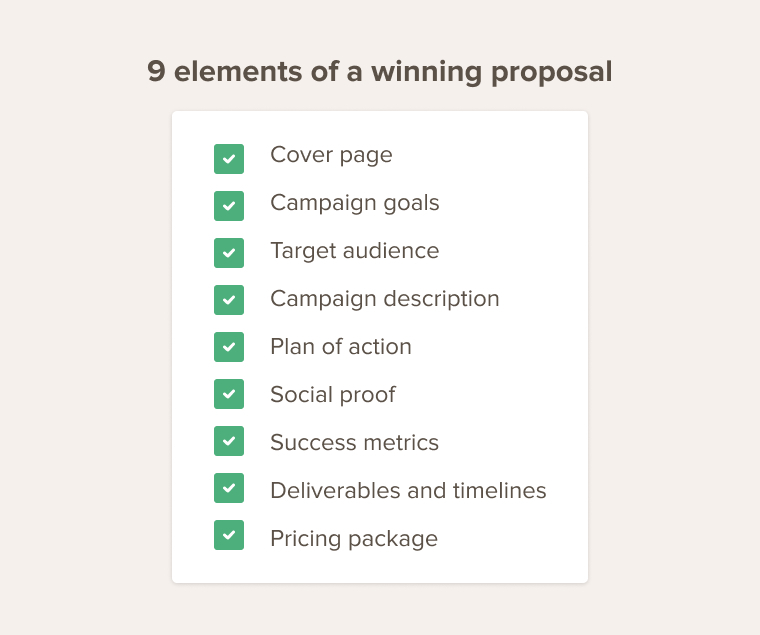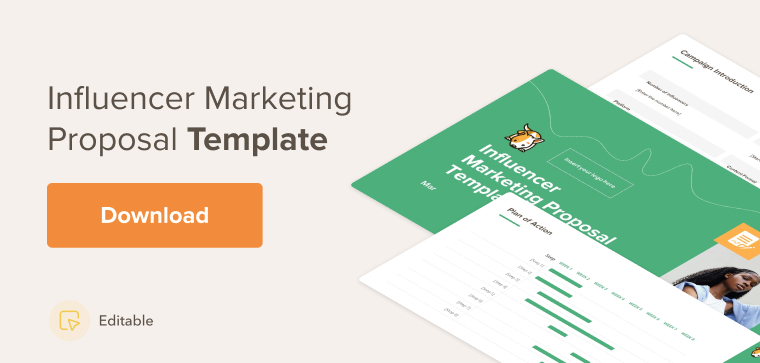Free Influencer Marketing Series
Success! Enjoy the series Part 1: How an agency took a brand from 0 to $1MM in 4 months using influencers & ads
Free Influencer Marketing Series
Success! Enjoy the series Part 1: How an agency took a brand from 0 to $1MM in 4 months using influencers & ads

How do you create a strong influencer marketing proposal –– one that makes your buyer say yes?
A good influencer proposal clarifies your vision. It’s like saying, “Here’s where we’re going, and here’s how we’ll get there.” When you present a solid proposal, clients feel confident. They know you’ve thought it through and can deliver results. It's clear about what you're providing (and not) and documents a step-by-step process for managing your campaigns.
A strong proposal will convincingly tell your story without your presence if your champion needs to get approval from a buying team.
In this article, we’ll cover the main elements of a strong influencer marketing proposal and provide a customizable template to fit your offerings and buyers.
An influencer marketing proposal spells out the influencer marketing services you, as the provider, recommend to a client or prospective client.
At this point, you’ve already met with the buyer and discussed their influencer marketing goals. You’ve recommended services to help them meet their goals — and they're interested. The next step is to send a proposal to formalize your offering, add some proof that you're the best partner for the job, and put a price on it. This will move the client closer to a yes or no.
Who uses an influencer marketing proposal? Influencer marketing agencies, digital marketing agencies, ad agencies, PR agencies, and marketing consultants or any experts who offer influencer marketing services to brands or other agencies.
Don’t confuse this service proposal with an influencer contract—–an agreement between an influencer and a brand or agency that covers the terms of the collaboration, such as the scope of work, compensation, and confidentiality clauses to safeguard any sensitive information.
Before you create a proposal, you make a pitch to introduce your business and services. The goal of the pitch is to sell your idea so you can move to a more concrete plan which you’ll outline in a proposal. A pitch should tell a prospect about you, your skills, the value you bring to the table, and why you’re the right fit to work with them.
This is usually done verbally before sending the proposal. It’s your pitch that helps the brand decide whether they'd like to move ahead with the project or not.
The proposal is a written document that puts everything you discussed in writing to formalize an agreement.

Before you put your fingers to the keyboard, here are some crucial elements of an influencer marketing proposal.
The cover page is the first thing a prospect sees, so it should offer a quick overview of your brand and why you’re reaching out.
This page should highlight two things:
Who wrote the proposal and the date
Contact details
Briefly describe the goals and objectives of your influencer marketing campaign. It could be increasing brand awareness, encouraging conversations, growing a community, or building reusable content.
Here’s where you’ll describe the target audience for the campaign. Also, briefly explain key audience insights and psychographic details, including specific locations you want to target, audience interests, and why they’d be receptive to this campaign.
Include campaign specifics, like:
Campaign start and end dates
Content types (e.g. Reels/Stories/ posts)
Copyright ownership details
Preferred platforms
Influencer types (e.g., follower size, niches)
Describe the process you’ll use to execute the campaign. This includes influencer selection, vetting and invites, brief creation and sharing, content schedule, and your approach to tracking metrics from influencers’ content and reporting.
In this section, you can also mention the influencer tools that you use to showcase transparency in tracking the campaigns.
Include client testimonials and case studies from past clients to showcase credibility and increase your chances of the proposal getting accepted.
Make sure testimonials and case studies are as relevant as possible to the prospective client. If you’re proposing a product seeding campaign, show a product seeding case study. If your prospect is a beauty brand, include testimonials or case studies from other beauty brands to show your industry-specific expertise.
Discuss what metrics you’ll use to measure success. You can beef up this section with data from past campaigns that show the KPIs you tracked and the success of a campaign.
Include the dates and deliverables for the campaign from start to launch. This makes way for clear communication and sets expectations for both sides.
Mention the total cost of the influencer marketing campaign. Give a breakdown of your services package to keep it transparent. Mention any one-time costs or retainer costs if it's a retainer project.
Now that you know the key elements to include in your influencer proposal, you can create one from scratch, or download and customize the template below. Download it here.

Whether you're customizing our influencer proposal template or creating a proposal from scratch, here are a few tips to keep in mind.
Give at least three pricing packages to the client. This way, they can pick the package that best suits their budget. Your highest package may offer more than what the client asked for—–but essential services they may not have considered. Or, a larger number of influencers to get them even bigger results at a better rate per influencer.
Social proof in the form of testimonials, case studies, reviews, and client logos lend credibility to your proposals and show prospects what you can achieve for them. Seeing who you work with and their positive experiences can help push a prospective customer closer to a yes.
Cesar Cobo, COO of Webris seconds this:
“Showcasing our previous successes has notably increased engagement and piqued interest in our offerings. These case studies present the campaign objectives, strategies used, and measurable results, providing credible evidence of our proficiency in influencer marketing.”
While it’s important to add all the important information in your proposal, try not to get stuck in the weeds. Revisit sections where you can briefly summarize the discussion and keep things clear and concise.
Don't make your proposals text-heavy. Instead, focus on making them interactive and incorporate visuals to break up walls of text.
You can turn data like audience insights, campaign reports, and metrics into graphics to add context to your proposals.
Include existing examples for inspiration. For example, you can include screenshots of content you think would work for the prospect or link out to previous campaigns that are similar in style or substance.

Jargon doesn’t tell a prospect anything about your proposal—–in fact, it just adds unnecessary words. Use direct, simple language to explain what you plan to bring to the table and what your expectations are for the campaign.
Jargon-heavy: Let’s synergize your brand’s core competencies with our influencer ecosystem. We’ll pick the low-hanging fruit for a results-driven influencer journey!
Easy-to-read: Let’s work together to get new audiences discovering and connecting with your brand through influencer marketing.
Add success metrics from past campaigns you’ve executed to show prospects what’s possible (but to also manage their expectations early).
Lisa Vetrone, Digital Director at Scenario Communications emphasizes why it is important to share the data from your past campaigns.
“Draw from data from past campaigns to set a precedent for the potential client to understand:
The objectives of influencer marketing campaigns and what your team can promise vs. deliver.
For influencer marketing projects that are largely focused on upper-funnel return rather than conversions, its helpful to show results from multiple previous campaigns to give a client a range of results of what they can expect.
Without a paid component, it is extremely difficult to guarantee coverage or have control over the messaging and quality of the content."
Know your client’s goals and pain points. It's easy for brands to reject your proposal if you don't personalize it to meet their goal and to overcome their challenges.
Be sure to get these two things right and include the key elements in your influencer proposal. Or if you want to save time, download our pre-made template, customize it to your brand, and fill in the gaps.
And, once you start winning more influencer marketing projects, be sure to provide a final campaign report to wrap up your results: all the influencers, their content and metrics, the most effective content, objectives vs. results, and key learnings. Here's a customizable campaign report template.
Finally, free up your time for more projects by automating how you track and collect content, and report on your influencer projects. Give us a try or schedule a call to learn more.